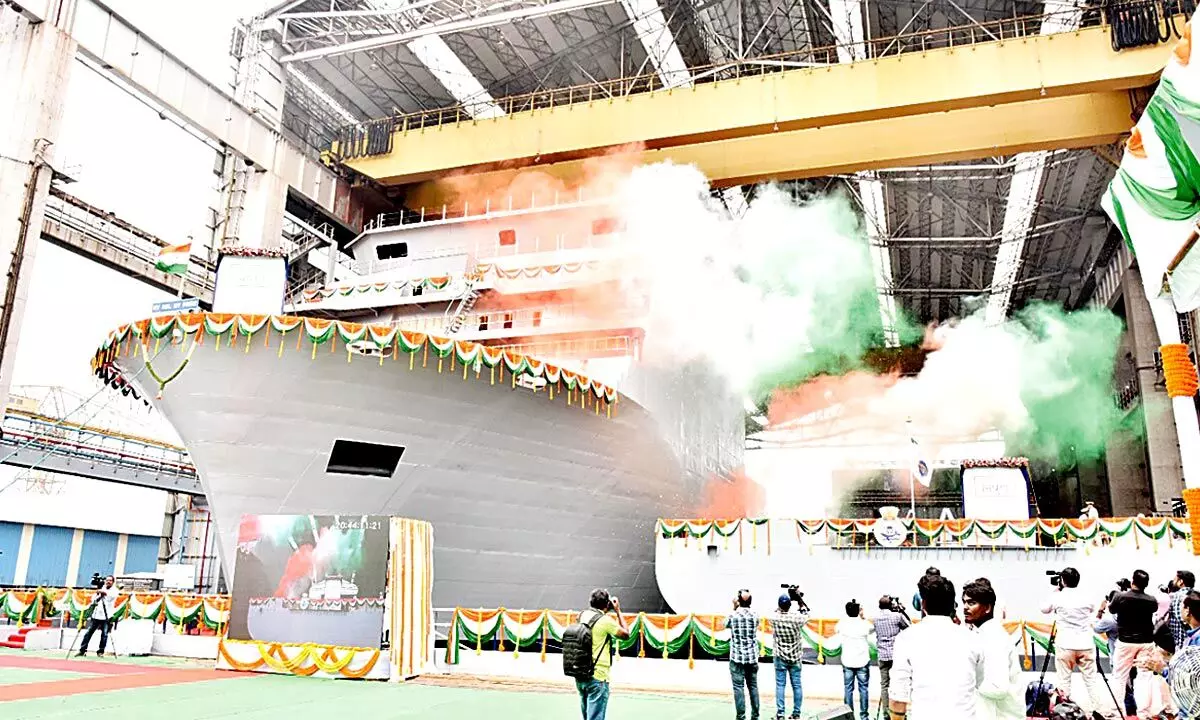Navy unveils 2 dsvs at HSL
Once commissioned, these indigenous DSVs will serve as INS Nipun and INS Nistar
image for illustrative purpose

The DSVs designed and built by Hindustan Shipyard Ltd will be deployed for deep sea diving and submarine rescue operations. The ship is 120m in length, a self-sustaining platform and can undertake operational deployments for a period of 60 days at sea
Visakhapatnam: With the launch of two indigenously-built Diving Support Vessels (DSVs), Hindustan Shipyard Ltd (HSL) , India's premier shipbuilding yard set up in 1941, has catapulted into the league of builders of warships for the Indian Navy.
"It is a matter of great pride and privilege to be here on this historic occasion of the launch of two sophisticated and key platforms of the Indian Navy. Once commissioned, these indigenous DSVs will serve as INS Nipun and INS Nistar," said chief of Naval Staff Admiral R Hari Kumar said in his address at a function organised here in connection with the launch of the two vessels. The vessels were launched by Kala Hari Kumar, president, Naval Wives Welfare Association (NWWA) in the presence of Commodore (retd) Hemant Khatri and a galaxy of officials from the ministry of Defence.
DSV is the first of its kind, indigenously designed and built at HSL for the Indian Navy. The DSV with blue water capability will be deployed for deep sea diving and submarine rescue operations. The ship is 120m in length with a complement of 215 personnel. It is a self-sustaining platform at sea and can undertake sustained operational deployments for a period of 60 days at sea.
The vessel is powered by two main engines to give a maximum speed of 18 knots. Majority of the items for key equipment of DSVs have been procured through indigenous vendors and from more than 120 MSME vendors across India.
The launch of Nistar and Nipun, the names given to the two DSVs, represent the coming of age of the expertise and experience resident in India's shipbuilding industry. Just a few days ago, India had commissioned the first Indigenous Aircraft Carrier INS Vikrant at Kochi. "Combined together, these ships reaffirm our growing stature as a 'Builders Navy', and a formidable maritime force capable of undertaking multidimensional and multispectral operations," the Chief of Navy said.
Nistar and Nipun, once commissioned, will not only herald a new era in India's deep ocean diving operations, but also enhance the Indian Navy's stature as a credible force and first responder to undertake critical operations such as submarine rescue operations in the Indian Ocean Region. In its previous avatar as a Submarine Rescue Vessel, INS Nistar was commissioned in 1971 and played an instrumental role in conducting diving operations on the Pakistan Navy submarine, Ghazi, which sank outside Visakhapatnam harbour during 1971 Indo-Pak war. The Indian Navy is the principal manifestation of India's maritime power, and plays a pivotal role in protecting, preserving and promoting India's national maritime interests. Towards this, IN deploys a multitude of assets, ranging from formidable aircraft carriers to small patrol vessels across our expansive areas of interest, the CNS stated. Admiral Hari Kumar said the DSVs are unique platforms that are being developed for undertaking specialised deep sea diving and submarine rescue operations. The induction of these versatile ships will not only boost our search and rescue capabilities, but also serve as a powerful tool in support of India's Deep Ocean Mission. The niche capabilities offered by these platforms reassure our stature as the 'first responder' to partners and friendly foreign countries across the Indian Ocean Region and is aligned with the Prime Minister's vision of SAGAR– Security and Growth for All in the Region. The Admiral said "while the Indian Navy fulfills its primary role of maritime security, we also contribute substantially to nation building through our steadfast commitment to Atma Nirbharta. The major recipient of Navy's capital budget investment is Indian shipyards." Of the 45 ships and submarines presently under construction, 43 are being built at shipyards across the country. In addition to direct economic 'plough-back', these indigenous ship building projects also act as a catalyst for significant employment generation and skill development (an employment generation factor of 6.5 i.e. number of personnel outside the shipyard, who get additionally employed for every single shipyard personnel employed).
He remarked that it is a matter of great pride and satisfaction that approximately 80 per cent of the DSV project's equipments are indigenously sourced from more than 120 MSMEs across India. The launch of these sophisticated and first of its kind platforms also cements India's status in an elite group of nations having the capability to design and build niche platforms. This is another step towards the Navy becoming 100 per cent Atma Nirbhar by 2047–an aim the country has set for itself.

